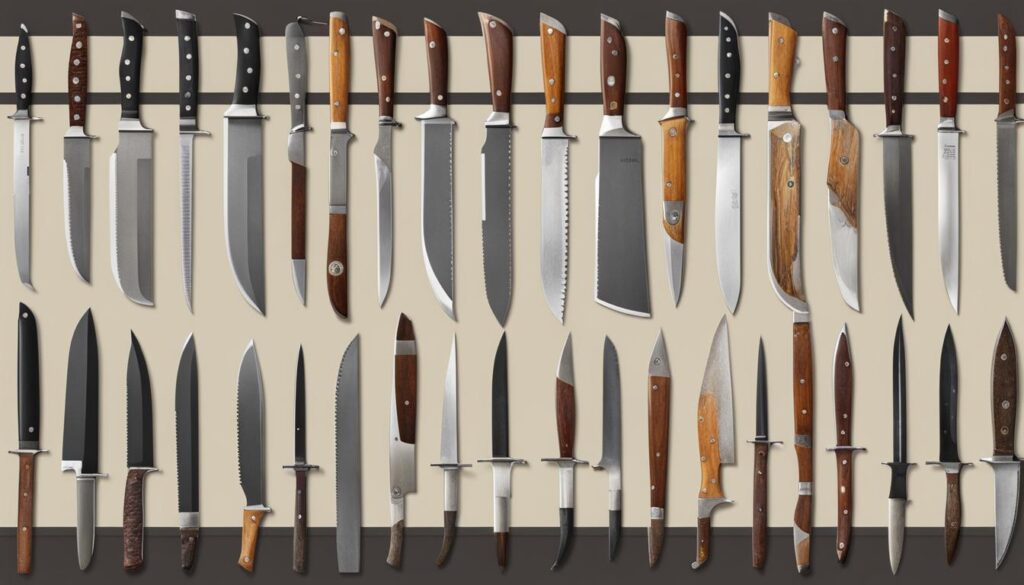Knives are essential tools for hunters, but they also pose safety risks if not handled properly. Proper knife handling techniques are crucial to ensure a safe and enjoyable hunting experience. By following the right practices, hunters can minimize the risk of accidents and injuries. Whether you are a seasoned hunter or new to the sport, it is important to prioritize safety when handling hunting knives.
Handling knives safely requires attention to detail and knowledge of the right techniques. Using a sharp knife is safer than using a blunt one, as it requires less force and provides better control. Hunters should always handle knives with care, use the right knife for the task at hand, and cut away from their bodies. When not in use, knives should be securely stored in a sheath and never carried while running. Additionally, it is important to ensure that folding knives have a properly working lock and to use a knife in a well-lit area for better visibility.
Key Takeaways:
- Safe knife handling techniques are essential for a safe hunting experience.
- Using a sharp knife improves control and requires less force.
- Handle knives with care and always cut away from your body.
- Store knives securely in a sheath and avoid carrying them while running.
- Ensure folding knives have a properly working lock and use knives in well-lit areas for better visibility.
Choosing the Right Throwing Knife for Knife Throwing Techniques
Knife throwing is a thrilling skill that requires precision and technique. To master the art of knife throwing, it is important to choose the right throwing knife. The right throwing knife can make all the difference in achieving accurate and safe throws. When selecting a throwing knife, consider its weight, balance, length, and handle design.
Weight: Throwing knives are typically lighter than regular knives. Lighter knives are easier to handle and allow for better control during the throw. Aim for a balanced weight that feels comfortable in your hand.
Balance: The balance of a throwing knife is crucial for a predictable flight path. Look for knives with a center of gravity located towards the handle or the blade’s center to ensure a good rotation in the air. A well-balanced knife will make it easier to achieve consistent and accurate throws.
Length and Handle Design: Throwing knives come in various lengths, and the right choice depends on your throwing style and comfort level. Longer knives may offer more stability and are suitable for beginners, while shorter knives provide more control and are favored by experienced throwers. Additionally, consider the handle design for a secure and comfortable grip.
By carefully considering the weight, balance, length, and handle design of a throwing knife, you can enhance your knife throwing techniques and improve your overall performance. Remember to always prioritize safety and practice in a controlled environment.
Mastering Knife Throwing Techniques for Accurate Throws
Mastering the art of knife throwing requires precision and practice. By mastering the proper techniques, you can achieve accurate and consistent throws that will impress both yourself and others. In this section, I will guide you through the essential techniques that will help you improve your knife throwing accuracy.
Grip Techniques
The grip is a fundamental aspect of knife throwing, influencing your control and accuracy. Two popular grip techniques are the hammer grip and the pinch grip. The hammer grip involves holding the knife with all fingers wrapped around the handle, providing stability and rotational force during the throw. On the other hand, the pinch grip involves holding the knife between your thumb and index finger, offering greater control and precision. Experiment with both grips and find the one that feels most comfortable and natural for you.
Throwing Stance
Having the right throwing stance is crucial for accurate knife throws. Stand sideways to the target, with your feet shoulder-width apart and your non-throwing hand extended towards the target. Raise the throwing hand to eye level, keeping your elbow slightly bent. This position allows for a smooth and controlled release, maximizing your chances of hitting the target.
Throwing Techniques
There are two primary techniques for knife throwing: the spin technique and the no-spin technique. The spin technique involves giving the knife a spin during the throw, relying on the rotation to stabilize and guide the knife towards the target. The no-spin technique, as the name suggests, does not involve any rotation and relies more on precise aim and control. Both techniques have their advantages, and the choice ultimately depends on personal preference. Experiment with both techniques and see which one suits you best.
Remember, mastering knife throwing techniques takes time and practice. Start by throwing from a short distance and gradually increase the distance as you improve your accuracy. Focus on consistency and precision, analyzing each throw to identify areas for improvement. By dedicating yourself to regular practice and honing your skills, you can become a master of knife throwing and achieve accurate throws with confidence.
| Grip Techniques | Throwing Stance | Throwing Techniques |
|---|---|---|
| Hammer grip | Sideways to the target | Spin technique |
| Pinch grip | Feet shoulder-width apart | No-spin technique |
“Accuracy is the key to successful knife throwing. With proper technique and practice, you can hit your targets with precision and accuracy.”
Improving Knife Throwing Accuracy with Essential Tips
Improving accuracy in knife throwing requires dedicated practice and attention to detail. There are several key tips and techniques that can help knife enthusiasts enhance their throwing skills and achieve greater accuracy. Let’s explore these essential tips to improve knife throwing accuracy:
1. Establish a Baseline
Begin by practicing knife throwing from a fixed distance. This will allow you to establish a baseline and track your progress over time. By consistently practicing from the same distance, you can measure your improvement and identify areas that need further refinement.
2. Analyze Technique
After each throw, take the time to analyze your technique. Pay attention to your grip, stance, release, and follow-through. Make necessary adjustments to improve your grip stability, stance alignment, and release consistency. Small tweaks in these areas can have a significant impact on your accuracy.
3. Video Recording
Consider recording your practice sessions on video. This allows you to review your throws and identify patterns or inconsistencies in your technique. By reviewing the footage, you can pinpoint areas for improvement and make necessary adjustments.
Remember to focus on specific target points on the object you are throwing at. By honing in on a specific target, you can improve your accuracy and develop consistency in hitting your mark.
Consistent practice, experimenting with different throwing distances, and learning from mistakes are essential for improving knife throwing accuracy. By implementing these essential tips and techniques, you can enhance your throwing skills and become a more accurate knife thrower.

Table: Knife Throwing Accuracy Tips
| Tips | Description |
|---|---|
| Establish a Baseline | Practice from a fixed distance to track progress. |
| Analyze Technique | Pay attention to grip, stance, release, and follow-through. |
| Video Recording | Record practice sessions for analysis and improvement. |
| Focus on Specific Targets | Improve accuracy by aiming at specific target points. |
The History and Evolution of Knives: A Comprehensive Handbook for Knife Enthusiasts
Knives have a rich history dating back thousands of years, evolving from primitive tools made of stone and bone to the modern-day knives crafted with advanced materials and technologies. This comprehensive handbook serves as a valuable resource for knife enthusiasts, providing insights into the various aspects of knives, their types, anatomy, terminology, maintenance, and uses across different fields such as culinary arts, outdoor and survival, and self-defense.
Exploring the history of knives not only deepens our understanding of these versatile tools but also sheds light on their significance throughout human civilization. From the early days of flint knives used for basic tasks to the refined craftsmanship of Damascus steel in ancient times, knives have played vital roles in hunting, cooking, craftsmanship, and warfare.
The handbook also delves into the world of knife collecting, highlighting the different styles, materials, and manufacturers that contribute to the vast array of knives available today. It offers guidance on knife laws and regulations, ensuring that knife enthusiasts are knowledgeable about legal requirements and restrictions.
Whether you’re a seasoned knife enthusiast or just starting to explore the realm of knives, this comprehensive handbook provides a wealth of information and serves as a guide to the history, evolution, and uses of these indispensable tools.


Key Highlights:
- Evolution of knives from primitive tools to modern-day craftsmanship
- Exploration of different knife types, anatomy, and terminology
- Insights into knife maintenance and care
- Uses of knives in culinary arts, outdoor and survival, and self-defense
- Guide to knife collecting, styles, and manufacturers
- Understanding knife laws and regulations
Conclusion
In conclusion, safe knife handling techniques are paramount when it comes to both hunting and knife throwing. By following these techniques, you can minimize the risk of accidents and ensure a positive and enjoyable experience.
When it comes to safe knife handling, it is crucial to choose the right knife for the task at hand. Using a sharp knife that is appropriate for the job not only increases efficiency but also reduces the likelihood of accidents. Additionally, practicing proper grip, stance, and release techniques is essential for mastering knife throwing and achieving accurate throws.
Regular practice is the key to improving knife handling skills. By dedicating time to practice and continuously learning and refining your technique, you can become a proficient knife handler. It is also important to stay up-to-date with the history and evolution of knives, as well as exploring the various uses and types available in order to expand your knowledge and appreciation for these versatile tools.
In summary, prioritize safety, choose the right knife, master your technique, and practice regularly. By doing so, you can confidently and responsibly handle knives, whether you are using them for hunting or engaging in the art of knife throwing.
FAQ
Are sharp knives safer than blunt ones for hunting?
Yes, using a sharp knife is safer as it requires less force and provides better control.
How should hunters handle knives to ensure safety?
Hunters should handle knives with care, use the right knife for the task, and cut away from their bodies.
How should knives be stored when not in use?
Knives should be securely stored in a sheath and never carried while running.
What should be considered when choosing throwing knives?
When choosing throwing knives, consider their weight, balance, length, and handle design.
What are the two popular grip techniques for knife throwing?
The two popular grip techniques for knife throwing are the hammer grip and the pinch grip.
What are the primary techniques for knife throwing?
The primary techniques for knife throwing are the spin technique and the no-spin technique.
How can accuracy in knife throwing be improved?
Improving accuracy in knife throwing requires consistent practice, analyzing technique, and focusing on specific target points.
What does the comprehensive handbook cover?
The comprehensive handbook covers different aspects of knives, including their types, anatomy, terminology, maintenance, and uses in various fields.
How can knife enthusiasts handle knives safely?
Knife enthusiasts can handle knives safely by prioritizing safety, choosing the right knife, mastering technique, and practicing regularly.





